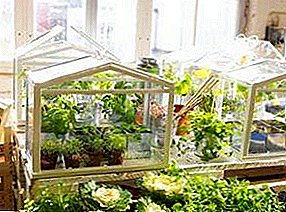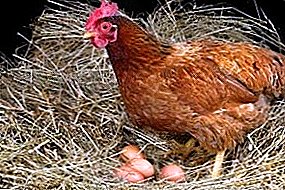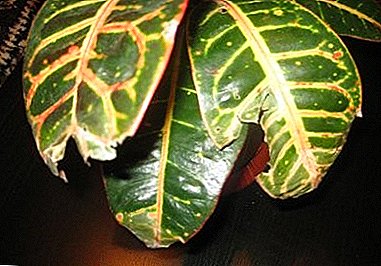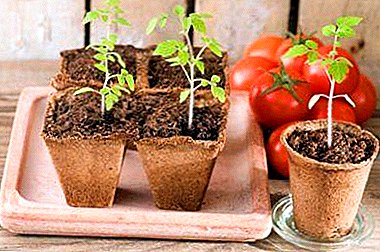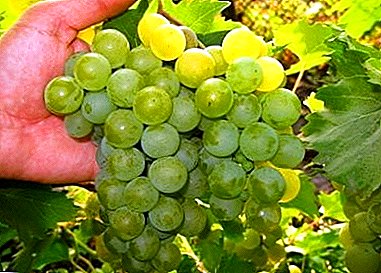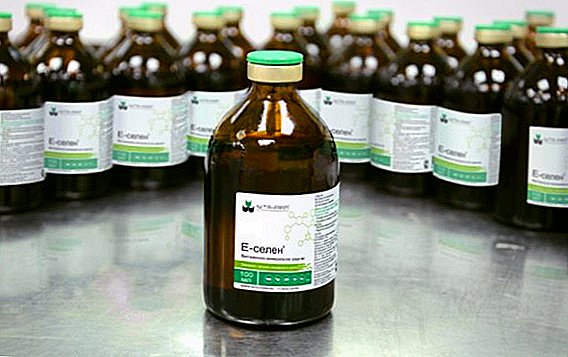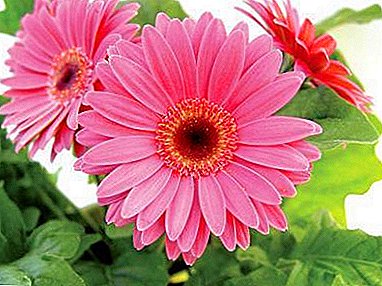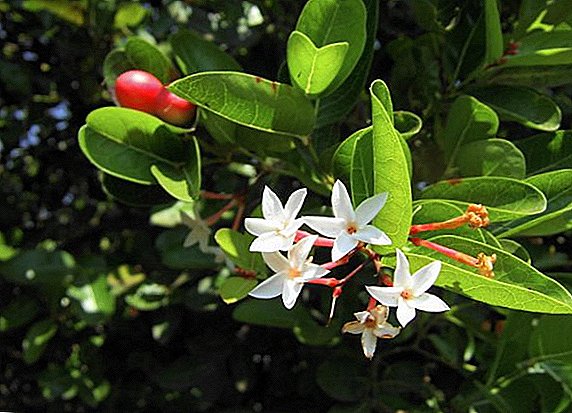 For those who like to decorate the interior of their home with unusual and exotic plants, we advise you to look at the Carissa or room plums. Care for her is not difficult, but it blooms very beautifully. In addition, in the open field or with manual pollination, it brings delicious fruits. How to care for Carissa at home and what difficulties may arise in this case, read our material.
For those who like to decorate the interior of their home with unusual and exotic plants, we advise you to look at the Carissa or room plums. Care for her is not difficult, but it blooms very beautifully. In addition, in the open field or with manual pollination, it brings delicious fruits. How to care for Carissa at home and what difficulties may arise in this case, read our material.
Description
Carissa (lat. Carissa) - This is an evergreen shrub or a small tree, which botanists rank among the Kutrov family. In the wild, it is strongly branched, and the trunk grows up to 8 meters in height. The crown can be as wide as the trunk. On the branches there are thorns. The leaves are oblong in shape, in length from 3 to 8 cm. Their upper part is wax, smooth, dark green in color.
At home, you can grow such exotic plants: pineapple, calamondin, medlar, kivano, feijoa, rambutan, pomegranate.
Throughout most of the growing season, Carissa is covered with beautiful snow-white or pinkish fragrant five-petal flowers. Their smell is reminiscent of jasmine, but it is weaker. Especially magnificently the bush is covered with flowers from May to September.  The plant brings red or dark purple berries, resembling a plum. Their size ranges from 1.5 to 6 cm in length. When the fruit reaches the peak of maturity, it forms from 6 to 16 flat seeds of brown or translucent color. Fruits can be eaten, all other plant organs are poisonous.
The plant brings red or dark purple berries, resembling a plum. Their size ranges from 1.5 to 6 cm in length. When the fruit reaches the peak of maturity, it forms from 6 to 16 flat seeds of brown or translucent color. Fruits can be eaten, all other plant organs are poisonous.
South Africa is considered the birthplace of Carissa. In 1886, it was brought to the USA, where it was tried to be planted in various states. Since 1905, the shrub has been introduced to the Hawaiian Islands. Since 1913, the first distributed in the Bahamas. Today it is widely cultivated in India, East Africa, the Philippines, and Israel, mainly with a decorative purpose and as a protective planting.
The genus Carissa has about 35 species and many varieties. Among them are dwarf, which are intended for cultivation in room conditions. Since the plant prefers to grow in a tropical or subtropical climate, it does not take root in our latitudes in open ground, the winter is too cold for it. The maximum temperature that it can withstand is up to -3 ° C (young specimens up to -1 ° C). 
Did you know? Many plants from the Kutrov family, for example, the acokanter and pachipodium, are classified as the most dangerous plants in the world. They contain lacteal juice (latex), alkaloids, cardiac glycosides. Of indoor plants for a person are dangerous desert rose or adenium, plumeria, allamand, oleander. When grown indoors, they are only handled with gloves.
Sorta
Working with Carissa, some breeders relied on its fruiting and tried to bring out varieties and forms with high yields, while others considered decorative and beauty of the plant to be their goal.
So, high-yielding varieties Fancy, Torrey Pines, Gifford, Extra Sweet, Alles (Chesley) were bred.
Among the dwarf and compact varieties, the most popular are: Bonsai, Boxwood Beauty, Dainty Princess, Grandiflora, Green Carpet, Horizontalis, Linkii, Low Boy, Minima, Nana, Nana Compacta, Prostrata and Tuttlei.
Of the species, four are most common:
- pencil (Carissa congesta);
- grandiflora (Carissa grandiflora);
- two-horned (Carissa bispinosa);
- large-fruited (Carissa macrocarpa).




Plant Care
Florists characterize the care of Carissa as uncomplicated, but with some difficulties. However, the cultivation of a flower is possible even for beginners.
Lighting
As a heat-loving plant, indoor plum loves bright and abundant lighting. If you plan to grow Karissa on the windowsill, it should go to the south side, in extreme cases - to the west or south-west. Otherwise, you will need to equip additional lighting. Otherwise, if there is a lack of light, the branches will be drawn out and thus have an unaesthetic appearance.
Temperature
The flower prefers a warm room, where the temperature in summer is kept at 18-25 ° С. In the period of calm - in the autumn-winter - the temperature of the maintenance of the plant will need to be reduced to 14-18 ° C. It is the creation of such a temperature difference that will provide conditions for abundant spring flowering. From March to October, the plant can be kept on a glazed loggia or on a balcony.
Balcony space can be adapted for growing garden and garden crops. Learn how to plant cucumbers, gladioli, marigolds, sweet peas, dill on the balcony.

The soil
To the soil of Carissa no special requirements. The main condition is weak acidity. It grows best in sandy and humus soil. Can tolerate saline soils.
Watering
Carissa should be watered regularly, but not abundant. The flower is able to endure a short-lived drought, but it copes poorly with the bays - with a strong waterlogging, the putrid process of the roots and the stem can begin.
The fact that the plant needs to be watered is evidenced by the drying of the top layer of soil.
Important! Potted plants should be watered only with a soft, warm for several days. by water (not below 20 ° C). Ideal for watering is thawed or rainwater.

Humidity
To humidity, the plant is not demanding. It equally well tolerates dry air in an apartment during the heating season and humidified with the help of special devices. The optimum humidity for growing Carissa is maintained at 45-55%.
Periodically, the plant can be bathed under a warm shower or sprayed. This will wash the room dust off it, the leaves will be able to breathe better.
Top dressing
Feed the room drain is necessary throughout the year. The optimal frequency is once every 14-21 days.
For abundant flowering phosphate fertilizers are required. With the beginning of the growing season requires the introduction of iron. In winter, should be fed minerals. 
Pruning
As a rule, Carissa forms a lush crown, therefore, to give it a beautiful and well-groomed shape will require frequent pruning. Note that since there are thorns on the branches, you will need to cut the plant with gloves to protect your hands.
Pruning produced in the spring. Remove the branches that contribute to the thickening of the crown, at the same time giving the flower a spherical shape. Sometimes it can be difficult to do this, because with strong thickening the branches can grow at different angles, as they like.
After the procedure, the plant is restored quickly and easily.
Transfer
Before the flower reaches the age of three years, it must be transplanted annually in the spring. After this transplantation is carried out once every three years. Transplanting for a plant is important because if it is not carried out, it will begin to release smaller leaves and stop growing.
For planting you can prepare the following substrate:
- turf ground;
- leaf earth;
- turf soil;
- peat soil;
- river sand.
Pot for planting is better to choose ceramic. With each transplant, it should be deeper and wider than the previous one. Drainage must be put on the bottom.
After transplantation, the plant should be abundantly watered and shaded for a few days from direct sunlight.
Pollination
 In the wild, the plant is pollinated by nocturnal insects. Where this is not possible, man produces artificial cross-pollination.
In the wild, the plant is pollinated by nocturnal insects. Where this is not possible, man produces artificial cross-pollination.
Breeding
Propagate Carissa in two ways:
- seed;
- vegetative - cuttings.
Seeds
 For sowing seeds need a light peat-sand soil.
For sowing seeds need a light peat-sand soil.
- Before planting the soil should be moistened.
- Seeds before sowing need to soak for a day in warm water.
- It is necessary to dig into the substrate to a depth of 0.7-1 cm.
- Planting should be covered with foil to create the effect of a mini-greenhouse.
 Sprouts should be expected in two weeks. After their appearance, the film must be removed. Plants propagated by the seed method, enter flowering only at the age of two.
Sprouts should be expected in two weeks. After their appearance, the film must be removed. Plants propagated by the seed method, enter flowering only at the age of two.Cuttings
Flowering plants propagated by cutting, can be expected in the same year.
- Cuttings should be harvested in the fall.
- They are cut from the top of the shoot, leaving three internodes.
- It is desirable to treat the cutting of the cutting with a root formation stimulator.
- Rooting substrate is prepared from peat and perlite.
- After planting, the cuttings are covered with film or glass jars.
 Rooting cuttings in water is not recommended due to their frequent decay.
Rooting cuttings in water is not recommended due to their frequent decay.Application
Besides the fact that the shrub is planted with the purpose of obtaining fruits, it is used for decorating areas, most often for planting hedges.
Choosing plants for hedges, you should pay attention to the barberry Thunberg, forsythia, calypod, hawthorn, boxwood.
The plant has been used in traditional medicine. So, the berries and leaves of the species Carissa pencils are used as an astringent to get rid of diarrhea. A decoction of the roots is used as an anti-invasive agent. Root processes are brewed to reduce pressure.
Nutritional value of fruits
Carissa fruits are ranked as fruits. Their skin is thin; the flesh is juicy, sweet or slightly bitter in taste, red. When biting, white juice is released. Seeds when eating is not noticeable.
Important! It is necessary to use only well-ripened berries, that is, soft and with dark red skin. Unripe fruits can cause poisoning.
 The nutritional value of fresh fruit - 61-62 kcal. They are rich:
The nutritional value of fresh fruit - 61-62 kcal. They are rich:- vitamins A, B1, B2, C, PP;
- calcium;
- magnesium;
- iron;
- sodium;
- phosphorus;
- copper;
- potassium
Despite the poisonous properties, for the treatment of diseases in traditional medicine, use the crow's eye, wolfberry, berry yew, ivy, cow parsnip, boxwood, grass flax, snyat, bathing suit.
Fruits are consumed fresh, added to salads, and also jam, jams, jelly, puddings, syrups are prepared from them. In Asia, they are used for filling in baking, in making curry, to decorate cakes. Indians from unripe berries prepare marinades.
Difficulties in growing
In case of errors in care, the plant will signal changes in its appearance. Thus, a strong drawdown of internodes most likely indicates that the flower is not comfortable at the place where it is located at the moment. Therefore, you should find for him another corner - lighter and warmer.
Too elongated branches and faded leaves indicate that the flower is not enough light. Provide an additional source or change the placement of the pot.  Blooming buds may be a consequence of too hot air in the apartment. The plant needs to create cooler conditions by frequent spraying, shading, or moving to another sill.
Blooming buds may be a consequence of too hot air in the apartment. The plant needs to create cooler conditions by frequent spraying, shading, or moving to another sill.
Dropping foliage suggests that the flower lacks moisture. Care must be taken to establish regular moderate watering.
Did you know? Of the plant species of the acocanter and pachipodium, which, like the Carissa, are included in the Kutrov family, the Bushmen mined poison for arrowheads.
Diseases and pests
With errors in planting and growing carissa, it can affect diseases and parasites.
Of the plant pests are terrible:
- spider mite - the presence of spider web on the trunk and leaves indicates infection;
- scutemia - signs of damage are yellow spots on the leaves and trunk, sticky liquid;
- Aphid - leads to wilting of buds and leaves, the appearance of small points and honey dew on the branches;
- thrips - about their appearance can be found by small black dots on the leaves, deformation of young shoots, silver plaque on the old leaves;
- whitefly - small white insects fly above the plant, larvae are visible on the lower part of the leaf plate.
 If the flower is too moist, it can cause gray rot. At the initial stage of the development of the disease, the death of the plant can be avoided by applying treatment with systemic fungicides (Teldor, Switch VDG, Horus VDH), copper-soap solution, 0.2% solution of Fundazol, 0.1% solution "Topsina-M". Usually requires two treatments. If the flower is very amazed, then it will not be possible to save it.
If the flower is too moist, it can cause gray rot. At the initial stage of the development of the disease, the death of the plant can be avoided by applying treatment with systemic fungicides (Teldor, Switch VDG, Horus VDH), copper-soap solution, 0.2% solution of Fundazol, 0.1% solution "Topsina-M". Usually requires two treatments. If the flower is very amazed, then it will not be possible to save it.It is better to use the power to grow a young bush, observing preventive measures that will not allow the development of the disease: to air the room more often, not to re-moisten the soil, stagnant moisture on the leaves with a sponge, do not put many flowers on one sill, process "Fundazol" and "Topsin-M "for the purpose of prevention.
Thus, Carissa is an original and beautiful plant that, with little care, will delight its owner with practically year-round abundant flowering and even fruiting. The main conditions that need to be provided for the flower for normal development and growth are adequate lighting, optimal temperature conditions, regular poor watering and frequent feeding, which is easily accomplished in a regular city apartment.
Recommendations for growing carissa from netizens
My Carissa seed initially gave 3 branches, and then began to grow in height. I pinch the very high, but she did not want to branch in any way. Then I pinched all three escapes - in the end, I grow a pair of new ones on all three. So do not regret, shred ...Evgenia
//forum-flower.ru/showthread.php?p=633186&postcount=191


